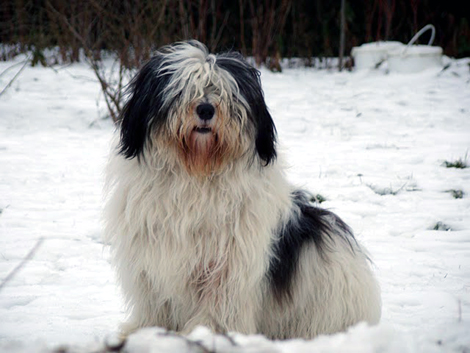|
Osteoarthritis (OA)
afflicts millions of dogs each year, and as active animals our
Beardies are at high risk of showing signs especially the older they
get. Poor conformation and joint injury are the major causes
of OA in dogs. One of the first things we can do is to make
sure that the parents have good conformation and that the puppy does
too. Hip structure should be evaluated either via PennHIP as
early as 6 months of age, or else by OFA at around age 2.
Unfortunately, OFA elbow analysis is of little value, but the good
news is signs of elbow dysplasia are far less easily masked than hip
dysplasia as there are no powerful muscles to support inadequate
joints.
We canít protect our puppies and older dogs
from all joint traumas because they need to lead the active lives
for which they were bred. While we can avoid jumping and
running immature skeletons on hard surfaces deliberately, our
puppies have other ideas. My three year old Beardie adores
vertical leaps and has been able to rise over 6 feet since she was 8
weeks old. However, I donít ask her to do this, as I did
with my almost 14 year old when he was young, and I will have to
rely on her good structure to hold up. Do watch out for high
speed collisions with other dogs and inanimate objects like walls
and trees as these may sadly come back to haunt you later.
Unfortunately, dogs are pretty good at hiding
pain, and itís often not until there is serious damage that an OA
flair up catches owner attention. Even then it may just
present as a mild limp. However, a thorough work up now may
slow down progression and provide pain relief for the affected dog.
Itís a sad fact that we generally under-treat pain. Be sure
to rule out tick-borne and autoimmune diseases as causes of joint
pain.
One of the major contributors to OA is obesity.
Itís never a good thing, but so much worse if a dog has OA.
What about exercise? Consistent low impact exercise is much
better than high impact. Weekend warriors and couch potatoes
are at much greater risk of joint damage than dogs that get regular
consistent work outs. Swimming, walking and running on
forgiving surfaces and regular massage are all great for our dogs.
Remember if your dog is an athlete to stretch him before and after
intense exercise rather than expecting him to perform with cold,
tight muscles.
As well as its role in preventing obesity,
nutrition can play an important role in preventing and treating OA.
Diets high in omega-3 and low in omega-6 fatty acids alter cell
membranes and reduce the inflammatory response that results in pain.
While glucosamine and chondroitin are helpful, the optimal dose and
ratio has not been determined. There is little data to show
that they prevent OA, but given that the damage that results in OA
probably starts a long time before symptoms become apparent there is
an argument to be made for using them to supplement the diets of
younger animals. Other ďnutraceuticalsĒ have also proven
helpful for relieving the pain of OA. It has been my
experience that what works for one dog may not necessarily work for
another and that some experimentation may be necessary. Needs
may also change over time, and switching supplements may prove
helpful. While initially being used to treat flare-ups of
pain, some dogs will need to be maintained on nonsteroidal
anti-inflammatory drugs (NSAIDs). We have heard a lot about
how dangerous these drugs are, but for most animals they are safe
and provide a vastly improved quality of life. In some cases
opiate analgesics may also be helpful.
Keeping your Beardies in good musculoskeletal
alignment throughout their lives is great preventative medicine.
Chiropractic adjustments done in a timely fashion can spare a lot of
misery as the dog ages. Acupuncture can provide excellent pain
relief, as can a lot of massage and other manipulative processes.
Optimally, of course, we would love to be able
to cure and reverse the damage to the joints, not just try to reduce
the pain. In the past we tried injecting steroids into the
joints, but these ultimately cause more cartilage destruction.
Polysulfated glycosaminoglycans (PSGAG Ė Adequan) injected
intramuscularly inhibit the enzymes that break down cartilage
thereby reducing its resistance to compression and resiliency. They
also act as precursors for formation of new cartilage; increase the
viscosity of joint fluid by increasing hyaluronate concentrations in
the joint, while reducing levels of prostaglandin E2 Ė
released in response to joint injury and causing inflammation and
ultimately pain. In horses PSGAG may be injected straight into the
joint, but this is not done in dogs. A new treatment which is
beginning to be seen more and more is the use of stem cells grown
from fat harvested from the recipient dog and injected into the
joints. Because they are specific to the dog there is no
rejection. The stem cells grow new cartilage, and the results
are quite remarkable in many cases. The biggest downside is
currently the expense, but we can only hope that this will
eventually fall
|

